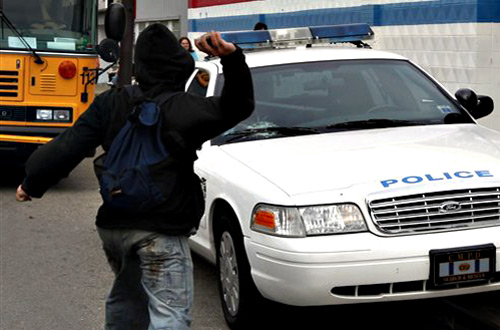
Disclaimer: This was written the night of September 24, immediately following the events described, without time to verify all the reports summarized or assemble additional information. There may be errors; if so, we will correct them shortly.
This is on-the-spot reporting just in from the first day of the G20 summit in Pittsburgh, which has seen a great deal of spirited resistance and confrontation—perhaps as much as has occurred at any anarchist mobilization in North America in half a decade. This gushy, hastily composed account presents the context, attempts to convey the spirit of the day, and raises a few preliminary questions.
The basic narrative of the day runs thus: The protesters attempt to reach the summit site, but are brutally forced back by police. They eventually turn around and march through Pittsburgh neighborhoods and shopping districts, where the police pursue and attack them. Property destruction intensifies in response to these attacks, and the conflict culminates in a standoff between police and students during which a black bloc destroys a business district.
One might interpret all this as legitimate acts of revenge for the police murder in London at last spring’s G20 summit; but it also signifies the survival of militant street resistance in the Obama era.
Never Felt More Alive
In the monotony of capitalist daily life, it’s easy to forget that we have a negotiable relationship to reality. Streets are for faceless traffic; crowds are impersonal assemblies of strangers studiously ignoring each other; windows are for displaying merchandise, or staring out of as we wait for shifts or classes to conclude; decorative stones outside banks or fast food franchises are inert objects devoid of interest or possibility.
When all this is interrupted and the unknown opens before us in every instant, the world becomes a magical place. In these moments, we discover new organs within ourselves—or if not new, then atrophied or atavistic—adapted for an entirely different way of life than we are used to. It turns out we are creatures made for another world—and made well for it!—who are barely getting by in this one. Changing worlds, we shift from malaise and misery to incredible joy and pleasure: finally, we are at home in our own skin, in our own environment. Charging down the street together rather than driving down it separately, fighting or outrunning police rather than submissively accepting their authority, we come to life.
No words can do justice to this experience, but it is real—one day of it is realer than a decade of rental contracts, traffic tickets, service work, and nights at the bar.
The Tension Mounts
The first out-of-town anarchists arrived in Pittsburgh apprehensively. The protests at the 2008 Democratic and Republican National Conventions had been almost the only national anarchist mass mobilizations in half a decade, and they had hardly been unqualified successes. Many around the country seemed skeptical of mass mobilizations, even including those who stated they were going to Pittsburgh.
In the anti-war era that concluded with the 2008 DNC and RNC, it had been standard for police to allege that about 5% of expected protesters would be “bad apples, and to craft their arrest estimates appropriately. But this time, while the police said they anticipated 3000 protesters, they announced that they expected to make up to 1000 arrests, ratcheting up the proportion of bad apples to 33%. Police arrest estimates in advance of the 2008 RNC had proved accurate—did that mean that practically every anarchist who attended the G20 protests could expect to be arrested?
On top of all this, the story circulated that 100-200 “nonviolent” inmates were to be released from Pittsburgh jails to make additional space for protesters. This itself counts as a victory of the mobilization, but at the time it sounded ominous.
The city announced that there would be something like 4000 police on duty, augmented by National Guard. Downtown Pittsburgh was practically a military occupation zone, with assault-rifle-wielding soldiers staffing road blocks and helicopters overhead.
The weekend before the summit, police harassment increased, with police paying visits in force to local collective houses thought to be occupied by anarchists. Several aggressive raids and preemptive arrests had preceded the 2008 RNC; these visits were tamer by comparison, but still brought back bad memories. Police also detained the Seeds of Peace bus that was to help provide food to protesters.
Tuesday afternoon, there was a picnic for protesters at Friendship Park, a mile east of Arsenal Park. Numbers seemed low, though some locals insisted there would be many more by Thursday. It seemed that some planned buildup actions weren’t coming together; indymedia reporters grumbled about having nothing to do. The Climate Convergence scheduled to coincide with the International Coal Conference September 21-23 appeared disorganized. No one knew what to expect next.
The Eve of the Storm
Click here for a map of the relevant area of Pittsburgh.
On Wednesday, September 23, while some bloggers complained of boredom, anarchists and other protesters were scrambling to prepare for the following day. How many people would come to the unpermitted mass march scheduled to leave Arsenal Park at 2:30 p.m.? Would the police block the march in the park, or attack it as it proceeded southwest towards the site of the summit at the tip of the peninsula of downtown Pittsburgh?
Some people were concerned that the presumed march route was a disaster waiting to happen; the two-mile corridor between Arsenal Park and the convention center passed between a river and a cliff, offering only a couple parallel roads and long stretches without exits that seemed perfect for blocking in crowds. The neighborhood was sparsely populated, marked by empty lots surrounded by barbed wire; it was a full twenty blocks to the shopping district outside the convention center. Surely thousands of police would be able to contain and mass arrest a march that made it far enough southwest towards the summit. On the other hand, other protesters argued strenuously against marching east away from the summit, on the grounds that this would lack clear messaging and could create tension with working class residents of the neighborhoods any other route would have to pass through.
The geography of Pittsburgh is challenging—cliffs, steep hills, and gullies break up the city in such a way that there are few routes between many neighborhoods. The northern part of central Pittsburgh, where the march was to begin, is sharply divided from the southern part, where many of the major universities and shopping districts can be found. Any route for the march, whether towards the summit or away from it, would involve a variety of risks. Some anarchists were only expecting a few hundred participants, a number which would be comparatively easy for the police to control.
Adding yet more suspense, the spokescouncil Wednesday night barely concluded in the midst of police intimidation; participants had to scatter as riot police and undercover agents surrounded the space. All night helicopters and police cars roamed the city.
September 24, 2009
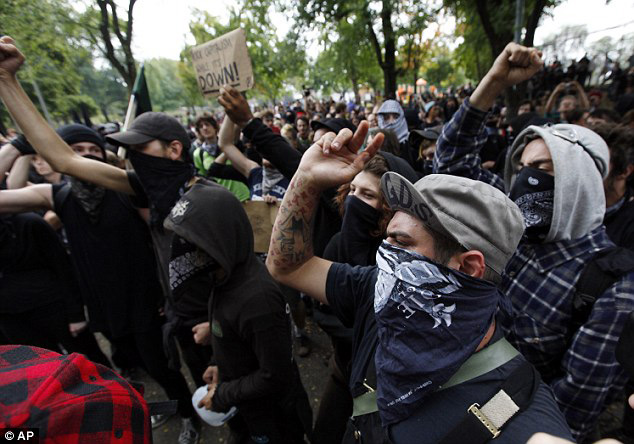
A student march arrived at Arsenal Park around 2 p.m.; by 2:30, the park had over a thousand people in it. This was a considerably different scenario than some out-of-town participants had anticipated.
Once you have a certain critical mass of participants, everything changes. A crowd that extends further than a city block is much more difficult to pen in; even if police can pen that many people in, they may lack enough vehicles or maneuvering space to arrest and transport them all. A broader diversity of participants, such as generally exists in larger crowds, can also discourage police violence. And while both police and protesters can lay concrete plans for an unpermitted march of up to a few hundred participants, past a certain threshold no plans can take into account all the unpredictable factors that result from so many people acting autonomously at once.
One might even extend this metaphor further to describe movements as a whole. So long as they remain small, they can be predictable and limited; but past a certain point of expansion, their energy and diversity give rise to a feedback loop that produces more energy, diversity, and expansion. Anarchists in the US are not used to organizing events in which more than 1000 people participate; sometimes it even seems we hesitate to try, whether for fear of being immediately quarantined by the police or out of lack of imagination. This can contribute to our own self-marginalization. The experience of being together in such numbers at Arsenal Park and in Pittsburgh throughout the remainder of the day was unfamiliar and exciting.
A tremendous amount of credit is due to the Pittsburgh G20 Resistance Project for doing such an impressive job involving participants in the Thursday action. The successes that occurred in the streets today would have been difficult or impossible without such numbers. Some anarchists had initially feared that it was a mistake that the unpermitted march was not scheduled to take place contemporaneously with other events; days of direct action at the 2000 and 2004 RNCs that were scheduled not to coincide with other actions had been unsuccessful, whereas the Seattle WTO protests and the 2008 RNC protests both succeeded because a wide range of protests occurred simultaneously. But, as Pittsburgh locals had insisted it would, it proved advantageous that no other actions were scheduled for the first day of the summit: it meant that the unpermitted march drew together everyone who wanted to oppose the G20, legitimizing direct action and involving participants from a wide variety of backgrounds. One comrade reports discovering early on that Cindy Sheehan was marching next to him in the middle of the black bloc.
First Movement
As large as the crowd was, leaving the park still looked dicey—riot police were blocking it to the east on 40th Street, and it appeared they could move in to block 39th at any point. Shortly after 2:30, a small segment left the park, moving up 39th towards Penn and Liberty, the two parallel avenues leading toward the summit to the southwest and into the Bloomfield neighborhood to the east. The rest of the crowd slowly filled the street behind them.
As soon as the crowd reached the top of the hill, the divisions over march route emerged. A small but spirited black bloc headed east toward the neighborhoods and shopping districts away from the summit, while others behind them shouted that they were going the wrong way and directed everyone southwest. Some of the latter reputedly shouted “Don’t take the bait!”—perhaps alleging that the attempt to go east was a infiltrator provocation. In any event, the black bloc returned to the crowd moving towards the summit.
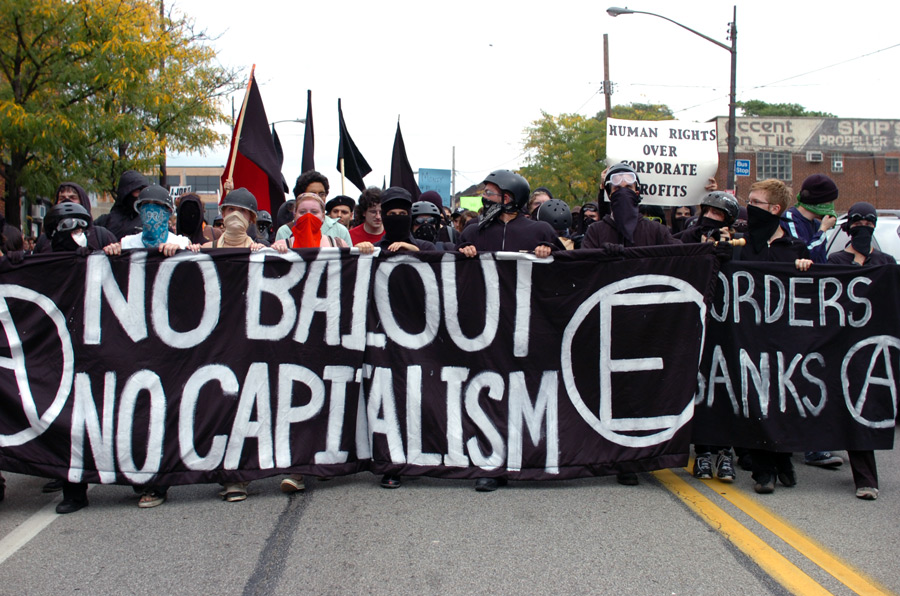
The march only proceeded a couple more blocks before running into a serious line of police resistance. A prerecorded dispersal order could be heard playing over a loudspeaker, punctuated by the crack of tear gas canisters being shot; this eerie refrain was to repeat over and over throughout the day in various situations, lending an Orwellian atmosphere to all confrontations with police. In such a large crowd, it was difficult for those towards the back to tell what was going on ahead; the sight and scent of tear gas in the distance was enough to send many moving down a side alley. Some anarchists emerged from the alley with trash cans and a mobile dumpster. At the foot of the hill ahead of them was another line of riot police and military vehicles, shooting tear gas and attempting to force them back with military audio weaponry that sounded something like a car alarm.
Imagine, if you will, gentle reader, the animist version of this story in which dumpsters, long accused of complicity in anarchist “lifestylism,” step out of their social role to join the social war. Free food, even when distributed via programs like Food Not Bombs, is not enough—we want freedom itself, and the dumpster does too, and it gains momentum down the hill as it rolls, alone and magnificent, directly into a pair of oblivious policemen.
There followed a period of chaos, as various contingents of the march attempted to make their way forward without being penned in by police. This was made more challenging still by the chaotic atmosphere, the fact that many groups had already lost track of each other, and the unfamiliarity of many protesters with the terrain.
In such a high-pressure situation, decisions take place anarchically, and not necessarily in the best sense of the term. Neither voting—noxious as many of us hold it to be—nor consensus process are possible. Instead, it is as if the hundreds of people involved are collectively operating a Ouija board, in which all their individual movements—conscious or unconscious—strain against or flow into each other, becoming something different and unfamiliar, even supernatural. A person or group can occasionally have agency, for example when one person’s shouting voice happens to be heard above the uproar: “GO LEFT!!!” That person may know exactly what he is talking about, or he may be a police officer; usually, one hears so many conflicting instructions that it is impossible to choose rationally between them. The crowd surges to one side, then to another. One may have personal goals of one’s own, but as the context is constantly shifting according to what others are doing and where they are going, one often cannot simply carry out one’s own program. This may explain the sensation of “losing oneself” described by rioters and psychology professors alike; it is simply a fast-paced microcosm of the way individuals struggle to make their own history as infinitesimal components of a much larger society.
The role of the stressful discussions that often take place before these events, then, cannot be to plan out exactly how they will go, but simply to familiarize the participants with some of the questions and possibilities.
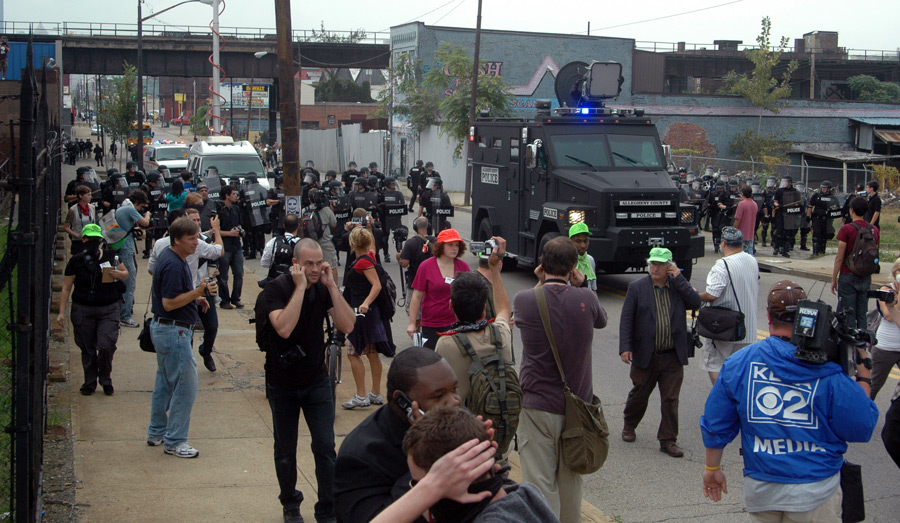
Second Movement
Some protesters remained in the neighborhood for over an hour, never making it more than a couple blocks further southwest, harried by police at every turn. Another body of marchers, numbering approximately 200, slowly began to move out of the area, returning east along smaller streets and soon ceasing to encounter police. Many of the neighborhood residents, especially the poorer ones, came out to watch and shout support from their doorsteps. The marchers emerged from the neighborhood onto Main Street, and shortly found themselves on Liberty Avenue where it turns to move southeast into the Bloomfield neighborhood. One way to view the events of Thursday afternoon is as a process in which the idea of going east rather than west slowly gained legitimacy. At first, participants had rejected it outright as a violation of the goals of the march; now, this retreating group reluctantly accepted it as inevitable, though not particularly desirable.
As Liberty Avenue makes its way southeast through Bloomfield, it passes through a shopping district full of small restaurants, bars, and banks. The march was remarkably timid in this environment, considering that there were no police around whatsoever. Perhaps it really is true that property destruction largely occurs as a reaction to police violence; it may even be that self-professed insurrectionists find it psychologically easier to smash things in the comparative danger of a police confrontation than in the absence of any authorities. In any event, there was practically no property destruction until finally a bank on one side of the street was attacked.
Police cars eventually appeared at the back of the march; they did not act until an the sirens of an ambulance approaching from the front were mistaken for police reinforcements, causing the crowd to panic and begin to disperse or move onto the sidewalk. The police took the initiative, and the march was dispelled.
Meanwhile, the comms office was being raided by police. One person arrested there is being held on $30,000 bail as of this writing, and another on $5000 bail. The comms system kept working, however.
Third Movement
At this point, it was almost 4 p.m. Friendship Park had been hinted at as a potential reconvergence point, and now the announcement went out over the Twitter system to regroup there. The participants in the march east down Liberty were already in the neighborhood, and moved north and west to meet their comrades at the park, who were filtering in from the deadlock to the west.
Soon the crowd was a few hundred strong. Some of those present had not expected the day’s events to go as far as they already had. Now they were inspired by the experience of taking the streets together, but not yet satisfied.
In contrast to earlier in the day, the general consensus now seemed to be that there was no sense in attempting to go west to the convention center, and that instead people should head southeast towards the plush shopping districts of the Shadyside and North Oakland neighborhoods. This was still a risky proposition, as those neighborhoods were separated from the Bloomfield neighborhood—in which Friendship Park was located—by geographical barriers.
And the police were no longer concentrated to the west, either. Now they too were gathering at the park and in the surrounding area. Before they could get control of the situation, a new march started out heading due south towards the intersection of Millvale and Liberty. Millvale crosses Liberty and spans a long bridge south into North Oakland; but such a bridge would offer an easy opportunity for police to surround a march, and there was a line of police already at the intersection. A great part of the march continued east down Liberty, picking up where the march an hour prior had left off. A bank in the area suffered broken windows.
Another group managed to cross the Millvale bridge into North Oakland, where the windows of a BMW dealership were smashed and strenuous games of cat and mouse ensued with police forces. Video footage from this area also shows fatigue-clad thugs kidnapping a protester from the area.
Meanwhile, the rest of the march continued down Liberty, at first outdistancing the police. Speed was of the essence at this point. Had the march moved any slower, dire consequences would surely have ensued for the participants; had it moved faster, things might have turned out better. Despite this, there were still some participants who insisted on shouting “Walk!” when others, aware of imminent danger, were calling out “MOVE!” or, more responsibly, “Slow jog! Slow jog!”
The march turned onto Baum, heading southwest towards North Oakland; lines of riot police appeared, attempting to secure the area and attacking marchers. The front of the march had rushed ahead to get around police lines, but some doubled back to defend their comrades by pinning the police down under a rain of projectiles. The police responded by shooting beanbag rounds, causing injuries. Meanwhile, a little further down Baum, protesters dragged a large section of chain-link fencing into the road to obstruct pursuit.
A few seconds later the march took off again down Baum, now at a run. A Boston Market franchise happened to be on this corner; protesters were enraged from the police attack, and it lost ten windows to a hail of rocks. Regrettably, there were people inside the franchise, who could be seen fleeing the windows; however, there is no indication that anyone was injured.

Now the bridge into North Oakland appeared, and the march crossed it at full speed. On the other side, a bank and KFC franchise suffered broken windows, and the marchers, aware that police were swooping in from all directions, began to break into smaller groups, ultimately dispersing and disappearing.
For the following several hours, North Oakland was filled with armored vehicles and riot police, roving the streets and blocking off areas to seemingly no purpose. When a person has an allergic reaction, it is often not the poison that causes the negative effects so much as his body’s reaction to it. Likewise, the relatively small actions of anarchists provoked a disproportionately disruptive police response. Everywhere an unpermitted march passed, a line of police cars and military vehicles followed; everywhere a window had been broken, traffic was halted by police blockades. All evening Pittsburgh locals could be heard on street corners and city buses decrying the police presence, the hassle of the summit, and the hypocrisy of their rulers.
Fourth Movement
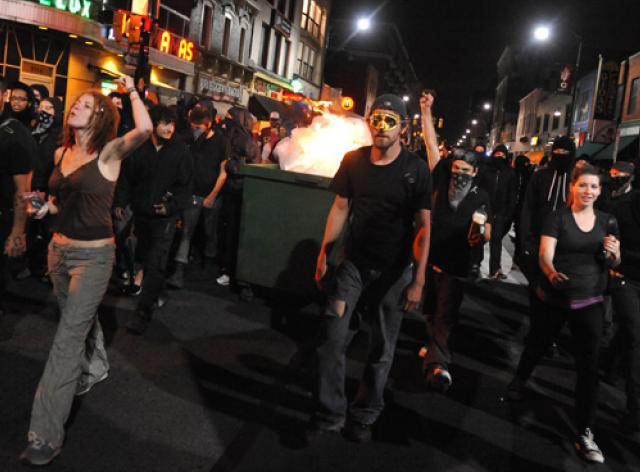
Click here for a map of the setting of these events.
On the other side of town, at the University of Pittsburgh in Oakland, people gathered at the Public Health Auditorium at 5th and De Soto, where a radical cultural event was taking place. The news came in during the performance of a particularly inspiring speaker that the police were raiding the Wellness Center at which injured and traumatized protesters were being treated. It was later announced that the police had not actually raided the space, but only threatened it; regardless, at this point no one present would have been surprised by any outrage on the part of the police.
Nearby, students had gathered close to the bridge to Schenley Park, where Obama had visited Phipps conservatory. Heavy-handed police repression ensued, including the usual electronic dispersal order and tear gas, but this only attracted more and more protesters and onlookers, and soon the crowd numbered up to 1000. Reports described students with t-shirts wrapped around their faces chanting “beer pong!” and “LET’S GO PITT!”; video footage shows them chanting more explicitly political slogans.
Shortly after 10 p.m., a Bash Back!-themed black bloc a hundred or more strong appeared on Forbes Street between Atwood Street and Oakland Avenue. The march was pushing half a dozen or more dumpsters, which were upended in the intersections while seemingly all the corporate businesses on the block lost their windows. Another dumpster was rolled further down the street and set alight before being upended as the bloc fled north.
We can imagine the atmosphere of the street at that instant: the running figures, the explosions of breaking glass reverberating off the buildings, the dim streetlights on masked faces, the sound of nearby sirens reminding everyone that militarized riot police in full force were on the way from only a couple blocks’ distance.
Pamela’s Diner, Panera Bread, McDonald’s, Bruegger’s Bagels, Subway, Rite Aid, FedEx Kinko’s, American Apparel, the Pitt Shop, and other businesses suffered damage. An H&R Block nearby on Atwood also reported vandalism. The bloc moved north, encountering a police substation on which a particularly bitter revenge was exacted. Police vehicles were already in pursuit and presumably speeding ahead to surround the march; however, the terrain of the college district was too open, and too populated by civilians, for the police to easily entrap their prey. Some participants broke off from the march at this point; others continued together as far as Craig Street, where Quizno’s Subs, PNC Bank, Irish Design Center, BNY Mellon, and Citizens Bank were damaged before the bloc finally dispersed.
Immediately thereafter, the police issued another prerecorded dispersal order to the students gathered in Schenley Plaza and around the so-called “Cathedral of Learning,” then fired several dozen tear gas canisters at the crowd. The following hours saw massive police occupation of the university area and ongoing clashes with students extending into their dormitories. As in St. Paul after the first day of the 2008 RNC, comparatively modest anarchist direct action provoked such a powerful police overreaction that the police ended up precipitating conflict with the public at large.
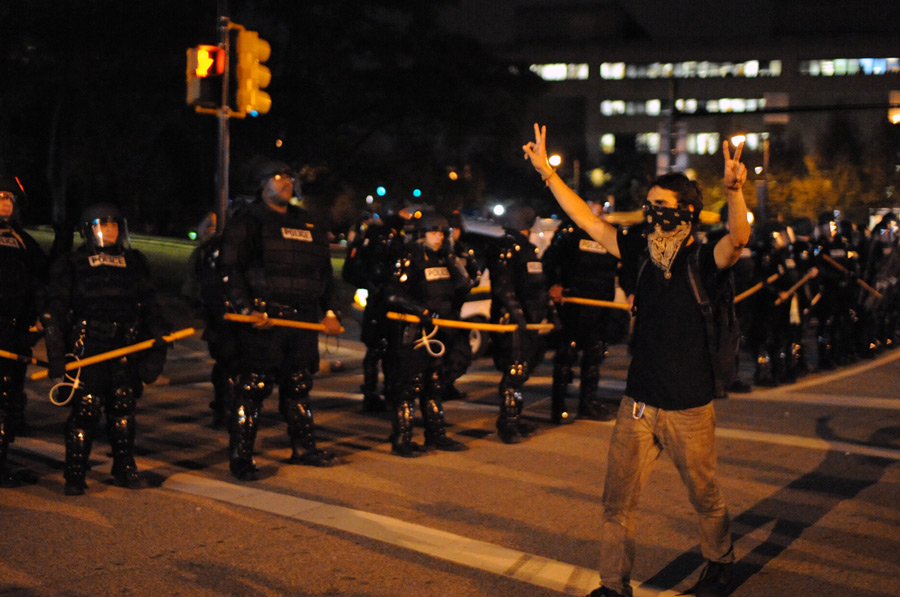
Recession Repression?
As of early morning September 25, corporate media reports cite 66 arrests, the majority of which happened during the evening and may include students caught up in random police attacks. Some of these arrestees have already been released; others are facing serious felony charges. Some charges may yet be filed, based on police and FBI intelligence.
The question remains—why didn’t the police succeed in controlling the demonstrators? Were there simply too many protesters, active in too many parts of the city, too mobile and often too savvy to keep up with?
Certainly, the rank and file of the police force in Pittsburgh are inexperienced—much less experienced than many of the protesters who have been in situations like this before. Video footage shows them forming sloppy lines, struggling helplessly with their equipment, dragging each other back from confrontations, and generally behaving like incompetent buffoons. It’s also possible that the city of Pittsburgh didn’t succeed in assembling their hoped-for 4000 officers; police officers are reported to have been brought in from as far away as Florida and Arizona.
Bearing all that in mind, though, the police were clearly ordered not to make mass arrests—that must have been an executive decision from above. There were several situations in which they could have tried to, but they never did. This is a change in approach from the 2004 and 2008 RNCs and the 2008 DNC. It’s possible that it is simply a local difference, but that seems unlikely. They promised up to 1000 arrests and carried out well under 100, even after repeatedly losing control of demonstrators all day long.
Is this the Obama administration finally coming through for anarchists? (Stay calm—it’s a joke, people.) Seriously, though, could someone high up have something to gain from letting anarchists destroy Pittsburgh? Or were their hands tied by factors we can’t know, like pressure to avoid seeming heavy-handed… or the financial constraints of the recession era?
At midnight at the end of the day, an announcement went out that police were having trouble getting fuel and were trying to get a tanker truck to come refill their Humvees. Another report claimed “police not responding to other calls: ‘all units are in Oakland.’” Perhaps this is just more of the misinformation common to the Twitter era; but it also sounds like the first signs of the capitalist empire suffering from overextension as its resources run out.
We can’t know how much this was a victory until the dust settles and the charges are filed. The 2008 RNC was exciting on September 1, but by the following week so many felony cases were pending that it was impossible to see it as an unqualified success. We’ll expand on this report as more information comes in.
But it’s important to convey the feelings we have at the end of a day like today, a day when we get to live the real lives we deserve, that we should be able to live every day. The exultation and joy we feel in moments like this is real, too—as real as our felony charges and the grim realities of long-term struggle.
P.S. One More Question for Extra Credit
Whatever happened to the puppets of the anti-globalization era?
Further Reading
- Pittsburgh Indymedia Coverage
- Extensive Corporate Media Article
- Corporate Media Report on Arrestees, Property Damage, and Injuries —bear in mind that this by no means is indicative of the actual number of injuries sustained by protesters.

